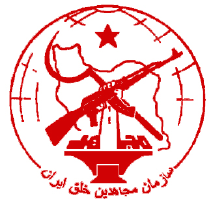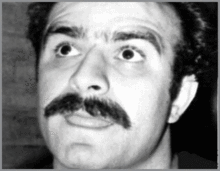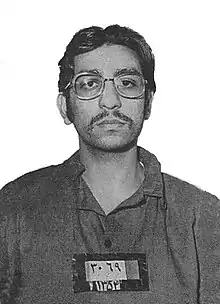Peykar
Organization of Struggle for the Emancipation of the Working Class (Persian: سازمان پیکار در راه آزادی طبقه کارگر, romanized: Sāzmān-e peykār dar rāh-e āzādī-e ṭabaqe-ye kārgar) or simply Peykar (Persian: پيکار, lit. 'battle'), also called the Marxist Mojahedin, was a splinter group from the People's Mujahedin of Iran (PMoI/MEK), the largest of Iran's guerrilla groups. Its members broke away from the MEK to support Marxism Leninism, rather than the Leftist Islamist modernism of the People's Mujahedin. Originating in 1972 and officially founded in 1975, by the early 1980s Peykar was no longer considered active.[3]


Organization of Struggle for the Emancipation of the Working Class | |
|---|---|
 Peykar's newspaper header including the slogan "Workers of the world, unite!" under the red star | |
| Leader | Alireza Sepasi-Ashtiani,[1]
Hossein Rouhani[2]
|
| Founded | 1975 |
| Dissolved | 1983[4] |
| Merger of | Some small Maoist groups and Marxist Mujahedin[5] |
| Split from | People's Mujahedin of Iran |
| Merged into | Communist Party of Iran[6] |
| Newspaper | Peykar |
| Membership (1980–1982) | Maximum 3,000 equipped with light weapons[7] |
| Ideology | Marxism–Leninism[6] Trotskyism[8] Maoism[9] |
| Political position | Far-left[6] |
Foundation
In 1971, SAVAK arrested and executed most of members of the MEK, including senior members and co-founders.[10][11]

This led to Marxist members joining the organization, including Majid Sharif Vaghefi in 1972, and Taghi Sahram in 1973. Other Peykar leaders included Bahram Aram, Torab Hghshenas, Aireza Sepasi Ashtiani, Rahman Vahid Afrakhteh, Foad Rohani, Hasan Alapoush, and Mahboobeh Mottahedin.[3]
Reforms within the MEK started at this time, with Taghi Shahram, Hossein Rohani, and Torab Haqshenas playing key roles in creating the Marxist–Leninist MEK that would later become Peykar. By 1973, the members of the Marxist–Leninist MEK launched an "internal ideological struggle". Members that did not convert to Marxism were expelled or reported to SAVAK, and Majid Sharif Vaqefi, the only Muslim left in the Central Committee, was executed.[12]
Muslim MEK members that did not convert to Marxism were expelled or reported to SAVAK.[13] Between 1973 and 1975, the Marxist–Leninist MEK increased their armed operations in Iran. In 1973 they engaged in two street battles with Tehran police. Also in 1973 they bombed ten buildings including Plan Organization, Pan-American Airlines, Shell Oil Company, Hotel International, Radio City Cinema, and an export company owned by a Baha'i businessman.
Schism
Mojahedin (Marxist–Leninist) became an official organization in October 1975. At this time the group continued to call itself People's Mujahedin.[14] Their position was laid out in a pamphlet entitled Manifesto on Ideological Issues, where the group's central leadership declared "that after ten years of secret existence, four years of armed struggle, and two years of intense ideological rethinking, they had reached the conclusion that Marxism, not Islam, was the true revolutionary philosophy."
This meant two rival Mujahedins, each with its own publication, its own organization, and its own activities. This continued just before the 1979 Iranian Revolution when the Marxist Mojahedin changed its name to Peykar (Organization of Struggle for the Emancipation of the Working Class) on December 7, 1978. This name later became the "St. Petersburg League of Struggle for the Emancipation of the Working Class", which was a left wing group in St. Petersburg, Russia. It was founded by Lenin in the autumn of 1895.[15]
Mujtabi Taleqani, son of Ayatollah Taleqani, was an MEK member who "converted" to Marxism. Hossein Ruhani was another prominent Peykar member. He ran for Majles candidate in Tehran, and caused a major scandal in 1980 by divulging for the first time secret PMoI negotiations with Ayatollah Khomeini. Ruhani also made Peykar "the first left-wing organization to personally criticize Khomeini", when he called Khomeini a "mediaeval obscurantist" and his regime "reactionary" and "fascistic." Later Ruhani was arrested and imprisoned. In May 1982 he appeared on television as one of the first of numerous opponents of the regime to recant their opposition in what is widely thought to have been the work of prison torture. Ruhani denounced his membership in Peykar, praised "the Imam" Khomeini and proclaimed that he felt freer in prison than "in the outside world."[16]
After 1980's
Peykar was operationally active in the early 1980s, mostly conducting small-scale insurgency-style raids in Northern Iran, though the group was also responsible for one hostage situation at the Iranian consulate in Geneva in 1982.[17] Peykar suffered after the Mujahedin June 1981 uprising, which it did not support but whose members were "arrested and executed en masse" afterwards nonetheless.[14]
Assassination of Americans
On May 11, 1976, the Washington Post reported that in January of that year, "nine terrorists convicted of murdering the three American colonels… were executed. The leader of the group, Vahid Afrakhteh stated that he personally killed col. Lewis Lee Hawkins in Tehran in 1973 and led the cell that gunned down Col. Paul Shafer and Lt. Col. Jack Turner." On November 16, 1976, a UPI story reported that the Tehran police had killed Bahram Aram, the person responsible for the killings of three Americans working for Rockwell International.[18][3]
In 2005, the Department of State attributed the assassinations of Americans in Iran to Peykar. The Country Reports issued in April 2006 stated that "A Marxist element of the MEK murdered several of the Shah´s US security advisers prior to the Islamic Revolution".[19][20]
See also
- People's Mujahedin of Iran
- 1988 Massacre of Iranian Prisoners
- Guerrilla groups of Iran
- Organizations of the Iranian Revolution
References
- Maziar, Behrooz (2000). Rebels With A Cause: The Failure of the Left in Iran. I.B.Tauris. p. 72. ISBN 1860646301.
- Abrahamian, Ervand (1999). Tortured Confessions: Prisons and Public Recantations in Modern Iran. University of California Press. p. 150. ISBN 0520922905.
- Arash Reisinezhad (2018). The Shah of Iran, the Iraqi Kurds, and the Lebanese Shia. Palgrave Macmillan. p. 8. ASIN B07FBB6L8Y.CS1 maint: uses authors parameter (link)
- Mirsepassi, Ali (2004), The Tragedy of the Iranian Left, RoutledgeCurzon, Table 10.2 Characteristics of principal secular left-wing organizations, 1979–83
- Vahabzadeh, Peyman (2010). Guerrilla Odyssey: Modernization, Secularism, Democracy, and the Fadai Period of National Liberation In Iran, 1971-1979. Syracuse University Press. pp. 173–174.
- Ḥaqšenās, Torāb (October 27, 2011) [December 15, 1992]. "COMMUNISM iii. In Persia after 1953". In Yarshater, Ehsan (ed.). Encyclopædia Iranica. Fasc. 1. VI. New York City: Bibliotheca Persica Press. pp. 105–112. Retrieved September 12, 2016.
- Razoux, Pierre (2015). The Iran-Iraq War. Hrvard University Press. Appendix E: Armed Opposition. ISBN 9780674915718.
- Sepehr Zabir (2011). Iran Since the Revolution (RLE Iran A). Routledge. p. 140. ISBN 978-0-415-61069-8.
- Jebnoun, Noureddine; Kia, Mehrdad; Kirk, Mimi, eds. (2013). Modern Middle East Authoritarianism: Roots, Ramifications, and Crisis. Routledge. p. 72. ISBN 9781135007317.
- Ḥaqšenās, Torāb (27 October 2011) [15 December 1992]. "COMMUNISM iii. In Persia after 1953". In Yarshater, Ehsan (ed.). Encyclopædia Iranica. Fasc. 1. VI. New York City: Bibliotheca Persica Press. pp. 105–112. Retrieved 12 September 2016.
- Alireza Jafarzadeh (2008). The Iran Threat: President Ahmadinejad and the Coming Nuclear Crisis. Palgrave Macmillan. p. 8. ISBN 978-0230601284.CS1 maint: uses authors parameter (link)
- Vahabzadeh, Peyman (2010). Guerrilla Odyssey: Modernization, Secularism, Democracy, and the Fadai Period of National Liberation In Iran, 1971–1979. Syracuse University Press. pp. 100, 167–168.
- Vahabzadeh, Peyman (2010). Guerrilla Odyssey: Modernization, Secularism, Democracy, and the Fadai Period of National Liberation In Iran, 1971–1979. Syracuse University Press. pp. 167–169.
- Abrahamian, Ervand, Tortured Confessions, University of California Press, (1999), p.151
- Iran Between Two Revolutions by Ervand Abrahamian, Princeton University Press, 1982, p.493-4
- Abrahamian, Ervand, Tortured Confessions, University of California Press, (1999), p.151-2
- MIPT Terrorism Knowledge Base. Peykar
- Lincoln P. Bloomfield Jr. (2013). Mujahedin-E Khalq (MEK) Shackled by a Twisted History. University of Baltimore College of Public Affairs. p. 17. ISBN 978-0615783840.
- Lincoln P. Bloomfield Jr. (2013). Mujahedin-E Khalq (MEK) Shackled by a Twisted History. University of Baltimore College of Public Affairs. p. 19. ISBN 978-0615783840.
- Mahnaz Shirali (2014). The Mystery of Contemporary Iran. Transaction Publishers. ISBN 9781351479134.CS1 maint: uses authors parameter (link)